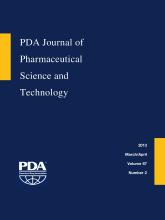Abstract
The objective of this study was to investigate the combined influence of three independent variables in the preparation of glipizide microspheres by the spray-drying method. A three factor, three level Box-Behnken design was used to derive polynomial equations and construct response surface plots to predict responses. The independent variables selected were concentration of polymer (xyloglucan) (X1), amount of crosslinking agent (X2), and feed rate (X3). Fifteen batches were prepared and evaluated for percentage drug entrapment and time for 80% drug release (t80). Response surface plots were constructed to demonstrate the combined effects of factors X1, X2, and X3 on response percent entrapment. The optimal microsphere preparations displayed a percent entrapment between 96.96 and 98.11 and a t80 between 420 and 439 min. The microspheres had particle size between 3 and 6 microns, and differential scanning chromatography thermograms showed the presence of glipizide in amorphous form in microspheres.
LAY ABSTRACT: Multiparticulate dosage forms are pharmaceutical formulations in which the active substance is present as number of small independent subunits. The microspheres as drug delivery systems are especially suitable for providing oral controlled release formulations with low risk of dose dumping, Microspheres can be blended suitably to attain different release patterns. Glipizide is recommended orally for treatment of type II diabetes and is administered in 2 or 3 doses of 2.5 to 10 mg per day. The development of controlled-release dosage form would offer effective control by releasing drug over period of time. The present work describes formulation of microspheres containing glipizide using the tamarind seed polysaccharide or xyloglucan as carrier. The spray-drying method was used to formulate the microspheres and variables (concentration of xyloglucan, amount of crosslinking agent, and feed rate) affecting performance parameters such as time for 80% drug release and percent drug entrapment were optimized using a statistical design (Box Behnken design). The microspheres had particle size between 3 and 6 microns, had entrapment between 97 and 99%, and sustained the drug release beyond 7 hours.
- © PDA, Inc. 2013
PDA members receive access to all articles published in the current year and previous volume year. Institutional subscribers received access to all content. Log in below to receive access to this article if you are either of these.
If you are neither or you are a PDA member trying to access an article outside of your membership license, then you must purchase access to this article (below). If you do not have a username or password for JPST, you will be required to create an account prior to purchasing.
Full issue PDFs are for PDA members only.
Note to pda.org users
The PDA and PDA bookstore websites (www.pda.org and www.pda.org/bookstore) are separate websites from the PDA JPST website. When you first join PDA, your initial UserID and Password are sent to HighWirePress to create your PDA JPST account. Subsequent UserrID and Password changes required at the PDA websites will not pass on to PDA JPST and vice versa. If you forget your PDA JPST UserID and/or Password, you can request help to retrieve UserID and reset Password below.






